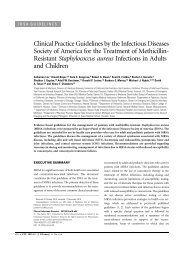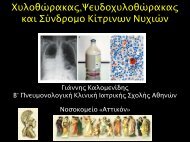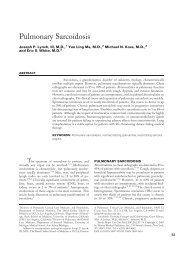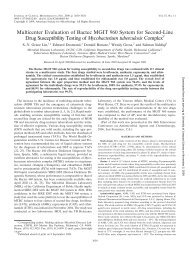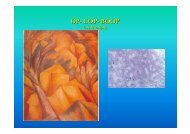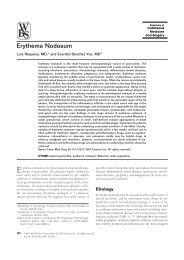010401 Allergy and Allergic Diseases
010401 Allergy and Allergic Diseases
010401 Allergy and Allergic Diseases
Create successful ePaper yourself
Turn your PDF publications into a flip-book with our unique Google optimized e-Paper software.
ADVANCES IN IMMUNOLOGY<br />
er. Techniques used to identify genes that are relevant<br />
to allergy <strong>and</strong> asthma include the c<strong>and</strong>idate-gene approach,<br />
which depends on the identification of polymorphisms<br />
in a known gene, <strong>and</strong> positional cloning,<br />
which links the inheritance of a specific chromosomal<br />
region with the inheritance of a disease. 22 Such studies<br />
have linked several loci to atopy, but the clinical<br />
relevance of these findings is unclear. Examples are<br />
the associations between an allele of the HLA-DR<br />
locus <strong>and</strong> reactivity to the ragweed allergen Ra 5 29<br />
<strong>and</strong> the linkage of atopy to a polymorphism of the<br />
gene for the b chain of the high-affinity receptor for<br />
IgE (FceRI-b) 30 <strong>and</strong> to the interleukin-4 family of<br />
cytokine genes on chromosome 5. 31 By contrast, certain<br />
alleles of the tumor necrosis factor gene complex,<br />
although linked to asthma, are independent of<br />
serum IgE levels <strong>and</strong> other measures of atopy. 32<br />
Polymorphisms of the FceRI-b gene appear to be<br />
associated with equal frequency to severe atopy, asthma,<br />
<strong>and</strong> eczema. Also, positional cloning indicates<br />
that chromosomes 2q, 5q, 6q, 12q, <strong>and</strong> 13q contain<br />
loci linked to both asthma <strong>and</strong> atopy. 22 Polymorphisms<br />
in the gene encoding the high-affinity receptor<br />
for bacterial lipopolysaccharide (CD14) have been<br />
linked to total serum IgE levels <strong>and</strong> may help explain<br />
the association between childhood infections <strong>and</strong> the<br />
development of atopy. 33<br />
Several of the genes <strong>and</strong> genetic regions that have<br />
been linked to atopy <strong>and</strong> asthma have also been implicated<br />
in rheumatoid arthritis (chromosome 2) <strong>and</strong> inflammatory<br />
bowel disease (chromosomes 2 <strong>and</strong> 12). 22<br />
There has been recent interest in loci with pharmacologic<br />
relevance. Polymorphisms within the promoter<br />
region of the 5-lipoxygenase gene 34 <strong>and</strong> in the b-adrenergic<br />
receptor gene may regulate the response to inhibitors<br />
of 5-lipoxygenase or b-adrenergic agonists,<br />
respectively. 22,34 These findings raise the possibility that<br />
genotyping will become useful in planning therapy<br />
for asthma <strong>and</strong> other allergic diseases.<br />
IgE AND ITS RECEPTORS<br />
Acute allergic reactions result from the release of<br />
preformed granule-associated mediators, membranederived<br />
lipids, cytokines, <strong>and</strong> chemokines when an allergen<br />
interacts with IgE that is bound to mast cells<br />
or basophils by the a chain of the high-affinity IgE<br />
receptor (FceRI-a). 35 This receptor also occurs on<br />
antigen-presenting cells, where it can facilitate the<br />
IgE-dependent trapping <strong>and</strong> presentation of allergen<br />
to T cells. 36 Eosinophils also possess FceRI-a, but in<br />
these cells it is almost entirely intracellular; after being<br />
released by degranulation of the eosinophil, it may<br />
help regulate local levels of IgE. 37<br />
The most important inducers of the production of<br />
IgE are interleukin-4 <strong>and</strong> interleukin-13. These cytokines<br />
initiate transcription of the gene for the epsilon<br />
class of the constant region (C e<br />
) of the immunoglobulin<br />
heavy chain. The production of IgE also<br />
requires two transcription factors, nuclear factor kB<br />
<strong>and</strong> STAT-6; the former pathway involves the costimulatory<br />
molecules CD40 <strong>and</strong> the CD40 lig<strong>and</strong><br />
(CD154), <strong>and</strong> the latter is activated when interleukin-4<br />
binds to the high-affinity a chain of the interleukin-4<br />
receptor. 38<br />
Allergens, including the products of some infectious<br />
microorganisms (e.g., Aspergillus fumigatus) <strong>and</strong><br />
helminthic parasites, evoke Th2-mediated responses<br />
that are characterized by high serum levels of IgE,<br />
whereas other bacterial antigens (such as those associated<br />
with Listeria monocytogenes <strong>and</strong> Mycobacterium<br />
tuberculosis) elicit a Th1-mediated response that<br />
is dominated by cellular immunity (the appearance<br />
of cytotoxic T cells <strong>and</strong> delayed hypersensitivity). In<br />
this latter class of organisms, the DNA contains repeating<br />
sequences of cytosine <strong>and</strong> guanosine nucleosides<br />
called CpG repeats. These CpG repeats can<br />
bind to receptors on antigen-presenting cells <strong>and</strong> trigger<br />
the release of interleukin-12. This cytokine, which<br />
is produced almost exclusively by antigen-presenting<br />
cells, drives <strong>and</strong> maintains the Th1-mediated response.<br />
Furthermore, the interferon-g produced by activated<br />
Th1 cells 39 <strong>and</strong> interleukin-18, produced by macrophages,<br />
39 join forces to suppress the production of<br />
IgE antibodies. 40 Therefore, at least theoretically, interferon-g,<br />
interleukin-12, <strong>and</strong> interleukin-18, either<br />
alone or in combination, have therapeutic potential<br />
for inhibiting the synthesis of IgE. Furthermore (as<br />
discussed below), CpG repeats may redirect allergens<br />
to produce a Th1-mediated, rather than a Th2-mediated,<br />
immune response.<br />
The physiologic relevance of the low-affinity IgE<br />
receptor (CD23) remains speculative. It may be involved<br />
in antigen trapping <strong>and</strong> presentation, thereby<br />
augmenting the production of interleukin-4 or interleukin-13.<br />
41 It can, however, override the positive<br />
effects of antigen presentation by combining with excess<br />
IgE <strong>and</strong> antigen under conditions in which high<br />
levels of interleukin-4 have caused the up-regulation<br />
of this type of receptor. 42<br />
ALLERGIC INFLAMMATION<br />
In a person with atopy, exposure of the skin, nose,<br />
or airway to a single dose of allergen produces a cutaneous<br />
wheal-<strong>and</strong>-flare reaction, sneezing <strong>and</strong> runny<br />
nose, or wheezing within minutes. Depending on the<br />
amount of the allergen, these immediate hypersensitivity<br />
reactions are followed by a late-phase reaction,<br />
which reaches a peak six to nine hours after exposure<br />
to the allergen <strong>and</strong> then slowly resolves. In the skin,<br />
late-phase reactions are characterized by an edematous,<br />
red, <strong>and</strong> slightly indurated swelling; in the nose,<br />
by sustained blockage; <strong>and</strong> in the lung, by further<br />
wheezing.<br />
Immediate hypersensitivity is the basis of acute allergic<br />
reactions. It is caused by molecules released by<br />
mast cells when an allergen interacts with membrane-<br />
N Engl J Med, Vol. 344, No. 1 · January 4, 2001 · www.nejm.org · 33<br />
Downloaded from www.nejm.org by VASSILAKOPOULOS THEODOROS MD on April 1, 2009 .<br />
Copyright © 2001 Massachusetts Medical Society. All rights reserved.



